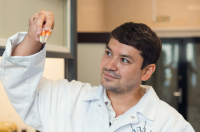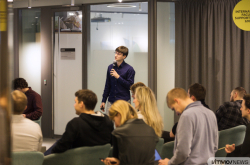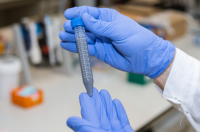The “project work” approach to education has been gaining in popularity lately. Its main advantage is that it gets students involved in actual practical work. They are offered to choose from a variety of open projects in engineering, research or innovation which are based on actual issues in science or industry. Even though they might be somewhat simplified to be accessible to school students, they are still relevant and in need of fresh solutions.
Due to the popularity of this format, there are many opportunities for high-schoolers to participate in such training. One such venue is the Sirius educational center, when every month a new session begins. Once a year, the special “project session” is held. This year, it began in late June under the theme of “big Challenges”. For 26 days, school students aged 14 to 17 worked daily on developing solutions to various problems.
Sirius is separated into four main “schools”: Science, Sports, Literature and Arts. The Science school, in turn, is split into 12 sections, each with a governing body or a supervising team. These specialists present their project ideas to the students. One of the sections, dedicated to microcosm and microscopy, it headed by ITMO University for the first time. The university has prepared three projects for the students.

Students at Sirius. Credit: sochisirius.ru
The section is headed by staff of ITMO University’s Department of Nanophotonics and Metamaterials: Prof. Alexander Golubok is head of the expert team, research associates Mikhail and Ivan Mukhin developed the methodology and postgraduate students Filipp Komissarenko, Mikhail Zhukov and Stanislav Lukashenko took on the roles of project leads. The team also invited expert speakers to give lectures to the entirety of the Science school’s students (150 out of total 400).
“The students were selected for the session based on their project work: for six months, they worked on projects and then sent their complete solutions to experts in the form of presentations. The experts, in turn, sorted them into various fields of study. The students were provided various tests and tasks to evaluate their knowledge and prepare them for their time at the school. Preliminary training was very important; after all, nanotechnology is a cross-disciplinary field of science that includes physics, chemistry, biology, computer science, etc. Teams were to be formed of members with different skills and competencies,” – shares methodologist Mikhail Mukhin.
According to the section’s staff, the key to this session’s success is the right choice of projects. All three projects were completed, each by its own five-member team.

Mikhail Mukhin, Alexander Golubok and Ivan Mukhin
“We prepared several projects in the three-four months leading up to the school. When we came here, we didn’t tell the children much besides the basic task; we gave them a basic introduction into the topic and set the goals. They came up with solutions on their own, organized their actions and planned everything themselves. Project leads were only there to supervise their work and help them figure out if a certain idea was working,” – explains Mr. Mukhin.
In preparation, staff and administration of ITMO University have set up a “nanoclassroom” in one of the university’s buildings. There, they placed equipment from ITMO’s Faculty of Physics and Engineering designed by NT-SPb. The section staff used it to ready themselves for the upcoming project work by working out and testing the fundamental aspects of the issues at hand.
ITMO University became the first-ever institution to bring its own equipment to the camp for the project school. Despite the wide selection of devices, materials and reagents at Sirius’s science center, some projects may require additional resources.
According to Filipp Komissarenko, one of the project leads, the high-schoolers even got to use equipment that many university students don’t have access to. The devices were made at ITMO University’s Technopark by resident company NT-SPb. Among the devices were the scanning probe microscope NanoTutor, probe assembly unit and an optical microscope. The equipment was used not only for ITMO University’s projects, but for other sections’ projects, too.

Filipp Komissarenko (right). Credit: sochisirius.ru
“What made us stand out from others was that we offered the kids an opportunity to familiarize themselves with the equipment on their own. Sirius also has NT-made probe microscopes, but they are overseen by an adult operator who would inspect the samples the students would bring him. We decided to use a different approach and teach our students to work with the equipment on their own, which turned out to be quite a fruitful initiative,” – shares head of the Microcosm and Microscopy section Alexander Golubok.
The ITMO team made a purposeful effort to pick three very different projects. The students split up according to their skills and personal interests. Biologists joined the project on titanium implant acceptance, chemists worked on nanoshampoo, while those into physics and optics looked into protecting document authenticity using nanotechnology.
“The work was very intensive. Starting at 8am and up until 11pm, the kids would work on their projects, doing things they would never get to try in school or even in an extra-curricular setting. They came here from all over Russia, from places with different educational environments – not all places have a Technopark and a chance to study nanotechnology. This was a major educational experience for them, and it is vital, among other things, for their occupational guidance,” – shares Mr. Komissarenko.
Each project included scientific, economical, engineering and social aspects. The resulting product, the educators say, is fully ready to be presented on the market. At the end of the session all the projects were showcased at a special event. Projects overseen by ITMO University received the highest marks.
Titanium implants
Russia is the world’s biggest producer of titanium, but all the high-quality titanium implants are imported from abroad despite the abundance of highly-qualified material scientists and an established titanium industry.
“We suggested our students to try and figure out why this happens and to look into the various methods of modifying the surfaces of titanium alloys for use in medical implants,” – says project lead Stanislav Lukashenko.

When working with titanium implants it is important to choose a non-toxic alloy and a clean technology for its production and surface treatment, as well as to manage its wettability.
“There are permanent and temporary (removable) implants; the students were tasked with finding out how the different treatment methods affect the wettability and the acceptance rate of implants. Since we were interested in both hydrophobic and hydrophilic properties, as well as minimal and maximum acceptance, the students had come up with a wide range of ideas and had a lot of space for creativity,” – comments Mr. Lukashenko.
The highschoolers conducted complex biological tests for their project. The surface’s micro- and nanostructures were studied under microscopes, made measurements and monitored cell growth rates. The experiments used cells of subcutaneous connective tissue of a mouse provided by Russian Academy of Sciences’ Institute of Cytology. The project is a good example of a cross-disciplinary project. It combines materials science, cell biology, chemistry, image processing and other sciences.
Nanoshampoo
For the second project, students have developed shampoo additives based on nanoparticles; one for greasy, and another for dry hair. They can be used with any hair product. The team’s task was to use nanocomplexes to improve a reasonably-priced shampoo brand. Since ancient times, people have been using herbal infusions and plant and animal extracts to care for their hair. With the development of new technologies, special nanoparticle-based additives have begun to be used for this purpose.

Mikhail Zhukov and project session students at Youth Conference Nanograd-2017. Credit: sochisirius.ru
Usually, only a single additive is added to a hair product, but the students have decided to use several. To get to the root of the issue, they used the scanning probe microscope NanoTutor, which allowed them to inspect hair cuticles at nanoscale. All in all, ITMO University’s team brought with them 10 nanoadditives; but even that wasn’t enough, and so they made a few more on their own.
“The kids have shown great interest towards this project and a high level of self-reliance, which we found very delightful,” – shares Mikhail Zhukov.
After the project was done, Nina Yanykina, head of ITMO University’s Project Management and Innovation Department helped the young inventors secure a patent. As Mikhail Shukov says, this project involved not only research and engineering; the students also worked on commercializing their work and even conducted a sociological survey.
In addition, the students have prepared a scientific article, which will soon be published, and filmed a commercial, thus completing the entire production cycle – from concept to putting their product on the market.

Nina Yanykina. Credit: sochisirius.ru
Security nano-markings
This project involved the creation of nano-markings for use in forgery protection of paper documents. As Filipp Komissarenko explains that, even though a lot of documentation is being digitized today, there is still a lot of paperwork in need of forgery countermeasures. All of the existing methods, such as watermarks, microprinting, etc., are implemented at macroscale level; this project, however, aims to develop a nano-scale protection that is undetectable at a glance.
In other words, it is difficult to tell if a document is protected, even using optical instruments, unless one knows where the marking is located. The markings are created using the NanoTutor scanning probe microscope, which, in addition to surface visualization, also performs nanoengraving. The protective nano-marking can be detected using an optical microscope in a dark field mode. To ensure protection from forgery, students proposed to make each marking unique. They also developed software to process the images and compare them to a database containing the individual images of each existing marking.

NanoTutor equipment
The size of the resulting markings is 100 microns, while the size of each individual element is 0.3. micron; for comparison, a human hair is approximately 150 microns in diameter. This method can be used to protect not only paper documents, but other important and unique objects. The technology can even be modified to be used on money. The project team has contacted Sberbank to offer them their new technology. According to project supervisors, the product is ready for retail use; the only current limit is the number of functional units.
For the next project session at Sirius, ITMO University plans to hold a competition among its staff and students to select the most innovative and unorthodox projects, as well as to present twice as many projects. The section name might see some revision, too; Alexander Golubok has proposed to rename the Microcosm and Microscopy section to “Nano-Range”, a name he believes would be more encompassing of all the various projects that would be related to modern nanotechnology.
“Having analyzed all the projects, of which there were 83, I can conclude that ITMO’s projects have turned out very successful. One indication of that is that our projects were highlighted in the media. This isn’t luck, but the result of a complex approach: we had the support of the university, the Project Management and Innovation Department, the Faculty of Physics and Engineering, and our partner company NT-SPb; not to mention an experienced section head, our driven postgraduate students and Mukhin brothers’ great work as our methodologists. All of these efforts were directed towards the same goal and helped us devise these projects that our students implemented successfully,” – says Alexander Golubok.
Nanograd
Two days after the project session at Sirius closed, the annual ten-day conference Nanograd was launched. It is organized by RUSNANO’s School League, a community of 400 schools involved in nanotechnology studies.
The students at Nanograd were tasked with solving real-life cases provided by nanoindustry companies. The tasks concerned nanotechnology, pharmacology, power engineering and education. Students also attended laboratory workshops where they could acquire new skills. Students signed up for the workshops of their preference on the first day of Nanograd. ITMO University had set up a workshop in scanning microscopy, with equipment provided by Technopark resident NT-Spb.

“Of course, in the course of our project work the students grew interested in our university – we told them about its particular features and invited them to come study at ITMO. At the closing of the session, we gifted everyone an ITMO scarf, which pleased them greatly,” – shares Mikhail Mukhin.
Over the course of seven days, high-schoolers learned to use a lithographic force microscope and showcased their achievements at the closing fair. Prof. Golubok also read a lecture on “Nanodiagnostics in Nanotechnology”.
“A lot of students came to ITMO University’s workshop on the first day – three times more than we’d expected. Such interest in technology reflects the attitude and drive of today’s school students. They were enthusiastic about learning the ropes of a scanning probe microscope. By the session’s end, inspired by the nanolithography process and the nano-marking project, they even printed some nano-markings on the play-act currency used at Nanograd” – tells us Vitaliy Shkoldin, head of ITMO University’s workshop lab.







